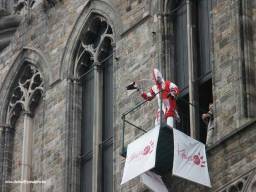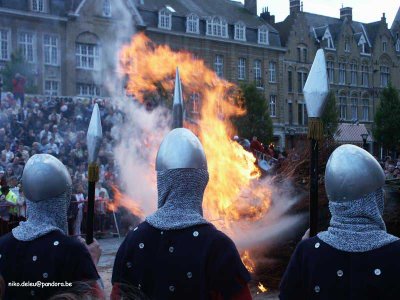Belgian Ritual of Tossing Stuffed Cats from a Belfry Makes a Jest of the Hideous Crimes of Capitalists and Catholics

In the confectioneries, marzipan was molded into feline images. In other shops, there were souvenirs, posters, brochures, masks, and postcards celebrating cats. Locals and tourists alike had their faces painted so that they might look like cats for a day. Folk music filled the air and in the cafes and bars good Belgian beer flowed freely.
In the street, as many as 2,400 colorfully-attired cat dancers (See photo above) entertained the crowd. There were stilted giants, buglers, banners, marching bands, and elaborate floats. As it is traditional, the beloved Cieper, king of cats (See photo below on the right), was in attendance as was his lovely spouse, Minneke Poes, the queen of cats (See photo below on the left). Costumed characters paid homage to the musical "Cats" and even Jim Davis' Garfield (See photo below) put in an appearance. Local politicians and big-shot capitalists, as indespensable to public ceremonies as VD is to unprotected sex, waved to the crowd from convertibles.

The highlight of the day was, however, Kattenworp, or the throwing of toy cats made of velvet and polyester from the two-hundred-thirty-foot bell tower of historic Cloth Hall by a jester (See photo farther down on the page) to the waiting throngs gathered below on the cobblestones of Grote Markt. The cats used to be stuffed with money but when the competition became too violent this practice had to be discontinued. A little later in the evening witches were burned in effigy (See photo at the bottom of the page) and the crowd was treated to a pyrotechnics display.
The occasion was the forty-first edition of Kattenstoet, or cats' parade, which was held May 14th in Ieper (Ypers), a small town of 36,000 residents in northwest Belgium, two-hundred-forty kilometers (75 miles) from Brussels. The town, which was completely destroyed when the German and English armies clashed there at the battle of Flanders Fields during World War I, has since been rebuilt to resemble the quaint medieval town that it was before the carnage. The In Flanders Fields Museum, dedicated to keeping alive the memory of the "war to end all wars," is located inside Cloth Hall. The tossing of stuffed cats from the belfry of Cloth Hall began in 1938 and a parade was added in 1946. Although the parade used to be an annual event, it lately has been scaled back to a triennial affair which is always held on the second Sunday in May.

While Kattenstoet is ostensibly a celebration of cats, all the pomp and ceremony cannot obliterate the memory of the horrible crimes that the city's merchants and the Catholic Church have committed against them in the past. Tant pis, although it is not known how cats are treated in modern-day Belgium, it is quite possible that some ailurophobes might use Kattenworp as a justification for harming felines.
During the Middle Ages, Ieper was a thriving textile town with eighty-thousand residents. In 1304, Cloth Hall was built in order to store wool and other linens and cats were accordingly employed to guard the fabrics from rodents. Once the cats began to multiply, the capitalists came up with an ingenious way to get rid of them and to have some fun at the same time. Thus, the odious practice of Kattenworp was introduced, only it was live cats which were tossed to their deaths from Cloth Hall's belfry.

The textile manufacturers' predatory capitalism was aided and abetted by the Catholic Church which along about this time had declared cats to be the familiars of witches. This provided the spiritual justification for Catholics to burn and beat to death millions of defenseless cats. Moreover, the Catholics' mass extermination scheme was so successful that by the time the bubonic plague struck there were too few cats left alive to check the rodent population which spread the deadly virus; consequently, one-quarter of Europe perished as the result of the "black death." To this day, the Catholic Church had never atoned for this despicable episode in its history.
As for Kattenworp, it survived from the fourteenth century up until 1817 and surely must have claimed the lives of at least hundreds of thousands of cats. This odious practice remains to this day not only a monument to the thankless and homicidal nature of capitalism, but also a reminder of the hypocritical and, at times, demonic nature of Catholicism.

Although Kattenstoet and its related events are no doubt intended as harmless amusement for locals and tourists as well as a money-making enterprise for the business community, the killing of cats and the alleged burning of witches is nothing for Ieper or any other community to be proud of or to celebrate. What the citizens of Ieper have done to cats in the past is despicable and if their descendants had any decency they would be too ashamed of themselves to even mention these atrocities, let alone celebrate and make money off of them. It is not known if any alleged witches were ever burned in medieval Ieper, but there is absolutely nothing amusing about this sorry chapter in western history.
According to local legend, cats enjoyed a far different status in Ieper before the arrival of textile manufacturing and Catholicism. Writing in the May 4th European edition of Stars and Stripes, Jane Traendly states that in pagan times a giant statue of a cat stood where Cloth Hall is now located. (See "Belgium's Cat Parade: Once Cruel, Now Just Playful.") As if in acknowledgement of the city's non-Christian past, the parade features a float bearing a costumed likeness of the Norse goddess Freyja in a chariot being pulled by two cats. Egyptian maus are also honored. (For a discussion of the perils faced by maus today, see Cat Defender post of April 13, 2006 entitled "Once Worshiped as Gods, Maus Are Now Being Poisoned to Death by Egyptian Authorities.")
The warlike and fatalistic Norse lived short and violent lives but the picture that emerges from both folklore and what little remains of the historical record that the conquering Catholics did not obliterate is that they at least had a modicum of respect for Mother Earth and the animals. It is hard to say the same for Catholics who still to this very day toss animals to their deaths from church steeples in Spain and use them as sacrifices in the Philippines. Moreover, although they never pass up an opportunity to condemn abortion, most Catholics are not only carnivores but also supporters of pet genocide.

Rather than reveling in the barbarism of the Middle Ages, it would be far preferable if the citizens of Ieper were to establish a permanent memorial in Grote Markt in honor of all the cats that their ancestors so horribly executed. This symbolic beginning should be accompanied by Ieper's dedicating itself to the abolition of all forms of animal abuse, especially pet genocide.
Flanders has been rocked recently by a spate of racially motivated crimes and the xenophobic separatist party Vlaams Belang (Flemish Interest) has been gaining in popularity. (See Washington Post, May 20, 2006, "Belgians Seek Roots of Racist Crimes.") It therefore seems clear that Ieper would be far better served by promoting tolerance amongst its divergent groups rather than by reenacting the burning of witches.
Photos: Niko Deleu. All pictures are from the 2003 parade.

<< Home